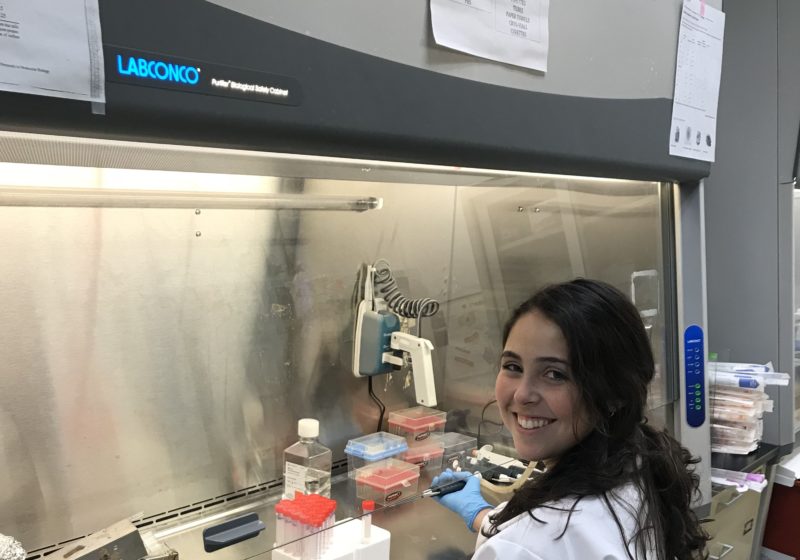Aging and disease research has a purpose beyond basic discovery: to improve human lifespan and health span. Comparative aging research focuses on studying how long-living species evade cancer and other diseases associated with aging. Megan Betancourt, a senior molecular genetics major, is studying the wound-healing abilities of naked mole rats at the Gorbunova-Seluanov lab in the biology department.
Naked mole rats have exceptional longevity: while a mouse might live for a maximum of five years, there have been reports of 34-year-old naked mole rats. Not only are naked mole rats long-lived, they’re also cancer-resistant and display remarkable wound-healing abilities. They heal flesh wounds quickly and with little scar tissue, employing mechanisms that may be directly applicable to therapeutics in humans.
“Naked mole rats are the coolest little animals,” Betancourt said. “They’re so complex, and there’s so much about them we don’t know.”
The Gorbunova-Seluanov lab found that naked mole rat skin cells produce high molecular weight hyaluronan, a large sugar molecule that mediates this rodent’s exceptional cancer avoidance. Betancourt hypothesizes that this molecule also plays an important role in scar-free wound healing. However, interventions must be validated in a mouse model before they can be tested in humans. Betancourt aims to determine if the unique wound healing properties of the naked mole rat are transferable to mice via hyaluronan.
To test if high molecular weight hyaluronan can improve wound healing, Betancourt performs experiments on mice genetically engineered to produce hyaluronan in large amounts. Interestingly, these transgenic mice healed wounds faster than both the control mice and the naked mole rat. They also showed less scab formation, and a decrease in collagen accumulation suggests that these wounds will heal with less scar tissue.
Excitingly, the lab has identified a small molecule, Delphinidin, that increases the amount of hyaluronan in tissues by inhibiting its breakdown. Small-molecule drug therapy is a common intervention in human trials, so determining the effectiveness of Delphinidin is important for downstream clinical applications. Betancourt is treating her mice with the drug, and observing how it impacts wound healing.
Working with mice is no simple task, especially when it comes to data collection. However, these studies better inform therapeutic potential than biochemical experiments in vitro or in tissue culture.
“In vivo work is really hard to quantify,” Betancourt said. “It’s not as precise, but you can really see the relevance — if we can better heal wounds from trauma.”
As a pre-med student, Betancourt balances research with other involvements and a heavy course load. As a GlobeMed committee member, she has planned fundraising events and traveled to India to meet with GlobeMed’s partner organization. Betancourt has also served as a TA for organic chemistry and introductory biology, and is currently a TA for Biology of Aging.
Through research, she has applied the knowledge she gained from taking courses in the biology and chemistry departments. “I was really motivated because I wanted to do something more than just school work,” Betancourt said. “It’s really important enrichment for your education to put what you learn in the classroom into practice.”
Betancourt has also served as president of her sorority and held two other high-ranking positions in organizations. This leadership experience complements her public-speaking abilities and confidence gained from giving lab meeting presentations.
To top off her packed schedule, Betancourt is training to run the Disney half-marathon this winter. Still, she is able to make research a priority. “The benefit of managing an independent project is that you can plan experiments around your schedule,” Betancourt said. “It’s been manageable and super rewarding for me.”
Next fall, Betancourt will attend medical school at UR. Though she’ll have to shift her focus to clinical training, she expects to maintain her passion for research. “I still want to do research in my future,” she said. “It will play a big role in my career.”
Doing wet lab research as a pre-med student has kept Betancourt’s options open by equipping her with critical-thinking and planning skills. In research and in other areas of her life, she can focus on the details while maintaining a broader understanding of her goals. “There’s no point in knowing the details if you can’t connect anything,” Betancourt said. “The lab has taught me to see the bigger picture.”
Though Betancourt loves doing research now, she didn’t always. In high school, she participated in wet-lab work and thought it wasn’t for her. Luckily, she gave it another shot at UR.
“If you’ve had a bad experience with research, it might just have been the wrong lab,” Betancourt said. “Try it again if you didn’t like it the first time!”
In planning her experiments, Betancourt always asks, “In the grand scheme of things, what is going to be useful?” Though this question may seem simple, it provides meaningful guidance. The cognizant mindset Betancourt has developed through undergraduate research will be invaluable in her future as a physician.




